The Moroccan energy sector A permanent dependence
Find out the historical, economic and political reasons for the dependence of Morocco’s energy sector, which threatens what remains of Moroccan sovereignty and aggravates social inequalities. And how it is that the most deprived populations in the country pay for the political and economic choices made by the colonized elite.
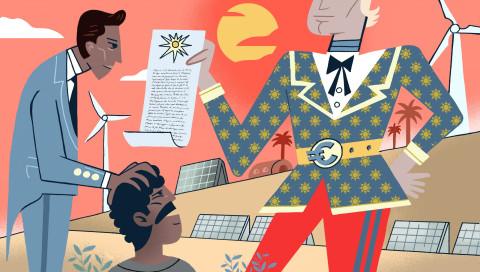
Illustration by Othman Selmi
Although Morocco gained its independence in 1956, the country’s energy sector has remained dependent – on fossil fuels and on the private sector. Over the period 2017–2020 fossil fuel imports accounted for around 90 per cent of total primary energy supply and 80 per cent of electricity supply1, while the private sector currently controls the majority of electricity production (84 per cent)2 and almost all energy distribution.
The ambitious renewable energy plan launched by the Moroccan government in 2009, which aims to cover 52 per cent of installed electricity capacity by 2030, could have significantly reduced the country’s dependence on largely imported fossil fuels. However, liberal policies adopted by the government for the entire energy sector, including renewables, as well as associated public–private partnerships (PPPs), have exacerbated both the debt crisis and the dependence on the private sector.
This article aims to understand the historical, economic and political reasons for the dependence of Morocco’s energy sector, which threatens what remains of Moroccan sovereignty and aggravates social inequalities. Furthermore, the article shows how in this situation it is the most deprived populations in the country that pay for the political and economic choices made by the colonized elite3, which serves as the partner of transnational corporations and international banks.
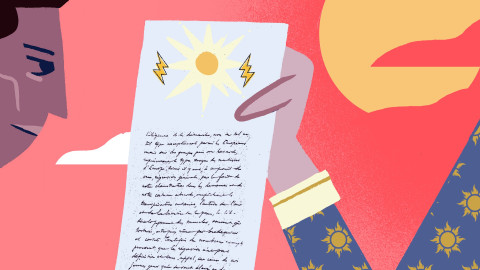
The energy sector: from colonial control to neoliberal measures
At the beginning of the twentieth century, the French colonizer’s main motivation in regard to electricity production in Morocco was to facilitate the extraction of raw materials, mainly phosphates, to improve mine productivity and to electrify the railway network that was used to transport raw materials to the metropole.4 The aim was to electrify what was considered to be ‘the useful Morocco’.5
Concessions were granted for the production and distribution of electricity. In 1914, the Société marocaine de distribution d’eau, de gaz et d’électricité (SMD) was created by the Société Lyonnaise des Eaux et de l’Éclairage. In 1924, this was replaced by Énergie Électrique du Maroc (EEM), founded on 30 January of that year by the Compagnie Générale du Maroc, itself created in February 1912 by a consortium of French banks led by the Banque de Paris et des Pays-Bas.6
Despite the advent of Moroccan independence in 1956, the management of the energy sector, as with other strategic sectors (such as agriculture, industry, trade, and drinking water supply), was only brought under the control of the Moroccan state in 1963, with the creation of the Office National de l’Électricité (ONE), the public institution that is in charge of the ‘public service, production, transport and distribution of electrical energy’, as stated in its founding decree.7
In the 1960s and 1970s, although it did not possess any, Morocco chose oil as its basic primary energy resource: oil accounted for more than 80 per cent of its energy mix in 1980.8 From the mid-1980s, and following the 1973 oil crisis, ONE decided to increase the share of coal in the country’s energy mix.
In the mid-1990s, in spite of ONE’s positive track record in extending the electricity network to rural areas and in providing a good-quality public service – measured partly by the absence of blackouts in major cities – the government decided to adopt the neoliberal paradigm with regard to the energy sector. Prompted by international financial institutions, it began to dismantle, privatize and liberalize the distribution and production of electricity, to the benefit of large transnational corporations.
As part of the adoption of the structural adjustment programme imposed by the international finance institutions following the debt crisis of the 1980s,9 Morocco launched a process of privatizing its most profitable public enterprises and liberalizing strategic sectors. The energy sector was among the first to be affected, with the privatization of the oil refining industry and the introduction of private production in the oil business. The Société Anonyme Marocaine de l’Industrie du Raffinage (SAMIR) was privatized in 1997 to the benefit of the Swedish-Saudi group Corral Petroleum Holding, mainly owned by Saudi billionaire Mohammed al-Amoudi. In the same year, drinking water and electricity distribution services, rainwater and wastewater collection, and public lighting in the Greater Casablanca region (with 4.2 million inhabitants) were assigned to a single operator, Lyonnaise des Eaux Casablanca (Lydec), a subsidiary of the French company Lyonnaise des Eaux (now Suez Environnement).
A large barrage of legislation and propaganda supported this first wave of privatizations, which was purported to be an indispensable process in order to ‘modernize’ the Moroccan economy and to benefit from the technical support of transnational corporations. However, the economic, social and ecological impacts of these privatization operations proved to be disastrous.
If we take again the examples of SAMIR and Lydec, the privatization of the former resulted in the biggest bankruptcy in the country’s history, with €4 billion debt to the state and over 800 workers – and their families – left destitute. As regards Lydec, various reports, including official ones – such as the 2014 Court of Auditors’ report – reveal numerous abuses of fundamental rights committed by the concession-holder with the collusion and/or silence of local authorities and elected representatives. These abuses included depriving people of their right to electricity and water connections and increasing the costs of these services, contrary to the provisions of the concession contract. In economic and financial terms, Lydec failed to fulfil the investment programme agreed in the contract and it also transferred money in foreign currency in violation of the contract, with €160 million transferred to shareholders in the form of dividends and €100 million transferred in disguised profits to its headquarters in the form of expenses relating to ‘technical assistance’ over the first decade of the concession.10
On the legislative level, in addition to Law No. 39-89 authorizing the transfer of public enterprises to the private sector, which kick-started the wave of privatizations in the early 1990s, two major acts passed during that decade deeply impacted the energy sector: Legislative Decree No. 94-503 of 1994, which ended the monopoly of ONE and allowed private electricity producers to enter the market; and Law No. 1-95-141 of 1995, which allowed the liberalization of the petroleum products market.
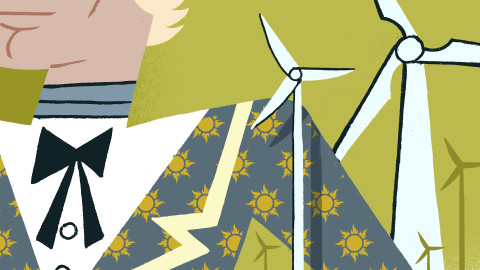
Renewable energy in Morocco: a ‘green’ neoliberalism
While Morocco has an ambitious programme and billions of Moroccan dirhams invested in the development of renewable energy, particularly solar, and hosts one of the world’s largest Concentrated Solar Power (CSP) plants,11 the country’s energy mix in 2011 remained dominated by fossil fuels, which accounted for 92.36 percent of the mix, mainly for transport, while coal constituted up to 57.82 percent of electricity production.
Moreover, the transport sector remains the largest energy consumer in Morocco, accounting for 38 per cent of the country’s total consumption.12 Almost entirely dependent on fossil fuels, it is responsible for about 50 per cent of the national energy budget, i.e. more than €4 billion in 2018, and represents 20 per cent of the trade balance deficit.
With regard to electricity generation, renewables provided 19 per cent of the national production in 2019, with 11 per cent from wind, 4 per cent from hydro and 4 per cent from solar energy. Coal remains the main source of electricity (65 per cent), followed by natural gas (11 per cent).13
A critical analysis of the main legislative and institutional reforms supporting the development of renewable energies in Morocco raises the question of whether this development has not mainly served as an excuse to further liberalize and privatize the energy sector.
Indeed, Law No. 13-09, promulgated on 11 February 2010, liberalized the renewable energy sector, allowing competition by private companies in both the production of renewable electricity and its export through the national grid.14
The law on PPPs came into force in August 2015, although the model of ‘public-private partnership [had already] long been experimented through contractual forms such as concessions outside any normative framework before the law enshrined this orientation’,15 allowing private operators to position themselves as independent power producers. These power purchase agreements (PPA) made under PPPs oblige the state (ONE) to buy the electricity produced at an agreed price for a period of 25 to 30 years.16
This model, and the 2015 law that followed, derive from the French PPP law of 2004. They notably take up the concept of ‘availability-based payments’, whereby ONE, a public institution, is obliged to buy the entire output that private concessionaires produce, regardless of actual needs. That energy, whether of fossil or renewable origin, therefore takes priority over that of public power stations.17 In the event of a sharp drop in electricity demand, since ONE is forced to consume private concessionaires’ production first, public power plants are shut down to avoid a blackout, which entails considerable extra costs for the state (i.e. taxpayers).18
This type of partnership thus constitutes a swindle that benefits banks and private operators. On the one hand, these are protected from any potential loss, whatever its nature (fluctuating commodity prices, infrastructure, public service provision, climatic risks, financial risks, etc.); on the other, the profitability of their investments is fully secured, as payment is guaranteed even if energy is not needed or used. This is a typical model whereby profits are privatized and losses and risks are borne by taxpayers.

Energy governance in Morocco: who decides, who benefits from it and who pays the price?
Who decides?
In Morocco, all strategic decisions relating to the energy sector fall outside of any form of democratic control. The creation of the Moroccan Agency for Renewable Energy (Masen) in 2019, the appointment by the King of Mustapha Bakkoury as its director and his recent disgrace reveal the autocratic methods applied to the sector. In fact, at the time he was appointed director of Masen, Bakkoury was president of the Authenticity and Modernity Party (PAM), founded by Fouad Ali El Himma, an adviser and friend of the King. In 2015, the decision was taken to extend the prerogatives of the solar agency to the entire renewable sector, with Bakkoury as its CEO, positioning Masen as the main player in renewable energy and de facto marginalising the ONE.19 Yet, in March 2021, the news suddenly broke that Bakkoury was forbidden to leave the country,20 as part of ‘the investigation [targeting him] for mismanagement and embezzlement in his capacity as the head of Masen, according to media sources close to the case’. No official explanation was provided at the time.21
Local communities and parliamentarians, as well as engineers and technicians from public companies in the fields of production, management, transport and the maintenance of energy facilities, have always been marginalized from all discussions regarding MASEN renewable energy projects. Their consultation would have helped avoid major technical errors and made it possible to better monitor the private ‘partners’, who, on their side, were surrounded by experts defending their interests. A specialist in the sector who requested to remain anonymous has stated: ‘Since renewable energies have become a strategic sector, the agency [Masen] has taken over all of the sustainable development prerogatives. It has become all-powerful. As in any big royal project, silence prevails: everyone knew that the projects were behind schedule and costing too much, but no one dared to ask for accountability’.22
Who benefits from it?
In 2018, ordinary citizens carried out an innovative boycott campaign via social networks against three brands whose owners are known to be closely related to the royal family: Danone, Sidi Ali and above all Afriquia. The latter is owned by powerful billionaire Aziz Akhannouch, who was appointed head of the government by the King in September 2021. Following this civil disobedience action, in 2019 the Conseil de la Concurrence (Competition Council) conducted an in-depth study on the oil sector, which found evidence of ‘dysfunctions’, i.e. fraudulent activities. The report found that instead of promoting competition – its advocates’ main justification – the liberalization of the sector in 2014 had led to a situation of oligopoly at all levels: from import, to storage and sale, and to distribution and consumption. With Afriquia owned by Mr Akhannouch leading the way, ‘the top five operators [captured] 70 per cent of the market in 2017, three of which [held] a 53.4 per cent share’.23
This oligopolistic situation increased with the closure of SAMIR in 2015, even though the latter had provided 64 per cent of the demand for refined products and had a large storage capacity (2 million cubic metres). ‘The energy bill has thus risen sharply, the trade balance deficit has worsened and small and medium-sized structures have been weakened to the benefit of the largest players’, according to an opinion of the Conseil Économique, Social et Environnemental (CESE) published in 2020.
Full private sector control of electricity
According to official government figures (see Figures 1 and 2), while the target of generating 42 per cent of electricity from renewable sources by 2020 was not met, the target of increasing the share of private concessions in electricity production was exceeded. At the end of 2021, the private sector controls more than two-thirds (71.8 per cent) of electric power production in Morocco.
The ruling elite have made private concessionary production, whether of fossil or renewable origin, a fundamental tenet and element of the energy system. This benefits first and foremost French (Engie), Spanish (Gamesa), Saudi (Acwa), Emirati (Taqa) and German (Siemens) transnational corporations, usually in cooperation with national companies owned by the royal family (Nareva) or by powerful and politically connected families, such as the Akhannouch and Benjelloun families (Green of Africa).
As an example, the May 2021 international solar energy tender for the design, financing, construction, operation and maintenance of the 800 megawatt (MW) Noor Midelt I project was awarded to a consortium led by EDF Renouvelables (France) which included Masdar (United Arab Emirates) and Green of Africa (Morocco).24 It is worth noting that Green of Africa is owned by three of the richest families in Morocco: Benjelloun (Financecom and BMCE group), Amhal (Omafu and Somepi group) and Akhannouch (Akwa Group). Before being appointed head of government by the King in September 2021, Aziz Akhannouch had held the post of Minister of Agriculture and Fisheries for over 15 years.
In the field of wind energy, Nareva, a company belonging to the royal group Al Mada (formerly SNI and ONA), is taking the lion’s share via its subsidiary Énergie Éolienne du Maroc (EEM). It currently owns five ‘merchant plant’ wind farms under Law No. 13-09, with a total capacity of over 500 MW, the electrical energy from which is sold directly to industrial customers.25 Nareva also owns the Tarfaya park, one of the largest in Africa, in a joint venture with the large French company Engie. The energy produced in this 300MW-capacity park is sold exclusively to ONE under a 20-year PPA.26
In 2016, Nareva was declared the successful bidder for the huge 850 MW Integrated Wind Project, consisting of Midelt (210 MW), Boujdour (300 MW), Jbel Lahdid (270 MW), and Tiskrad (in Tarfaya) (100 MW). Nareva won this project by partnering with wind turbine manufacturer Siemens Gamesa Renewables (Germany–Spain).
It should be stressed that while the Al Mada group, which owns Nareva, presents itself as a leader in the field of sustainable development, it is responsible for the destruction and pollution of several ecosystems. As the author has explained elsewhere: ‘Not only has its sugar producing company Cosumar been involved in pollution disasters but its mining branch Managem in its “Imider” silver mine, located in the south of Morocco, has seen the contamination of aquifers and there is still an ongoing conflict with the local population over water resources’.27
In Morocco, as is seen in other countries, those who benefit from green projects generally have a long track record of polluting and destroying ecosystems. Reorienting part of their investments towards renewable energy is in reality just another, often even more profitable, way of generating financial profits and dispossessing local populations of their territories.
Who pays the price?
The population, both as taxpayers and as consumers as a whole, bears the financial consequences of a system that is designed to be totally inequitable and to benefit exclusively private investors. The concession contracts signed in the 1990s and early 2000s, in particular the PPAs, obliged ONE not only to buy energy from private operators according to availability and at prices that are higher than the effective selling prices for distribution and consumption, but also to bear the cost of fluctuations in the prices of raw materials, in particular coal.
This plunged ONE into an unprecedented structural financial crisis, with the government then bailing it out, through the signing of a programme contract that allowed ONE to increase consumer prices. As a result, consumer bills rose by 20 per cent in 2014.28 As recent renewable projects are all based on similar 30-year contracts, this situation of massive public investment without any guarantee for the population of lower electricity prices is likely to be repeated.
Masen’s decision to pursue CSP technology, which was made without consulting any public body including the ONE, has proven disastrous, with a cost price per kilowatt-hour (KWh) of 1.62 dirham for Noor 1, 1.38 dirham for Noor 2 and 1.42 dirham for Noor 3, while the price at which each KWh is sold to ONE is 0.85 dirham. Masen thus records an annual deficit that is estimated by CESE29 at €80 million for the Noor I, II and III plants.
The issue of debt and financing is fundamental. All recent power generation projects, including the so-called ‘green’ projects, are financed by loans from international private banks, multilateral banks, the International Monetary Fund, the World Bank, the African Development Bank, and French, German and Japanese development agencies. In the solar energy sector, Masen contracts debts that are guaranteed by the Moroccan state. It uses these funds to develop the infrastructure (roads, hydraulic infrastructure, fences, lines and transformer stations for the transport of energy) needed for project development. And it also uses the funds to finance its participation in the special purpose companies created for specific projects (Noor ourzaztae, Noor Midelt, etc.), as illustrated in Figure 3 below:
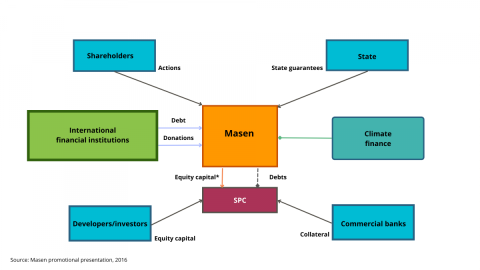
Masen promotional presentation, 2016
Lenders remain the key players in these projects and have the final say on all strategic decisions. Consequently, it is only logical that the lenders’ nationality(ies) correspond to that of the companies involved in the project, whether as operators (French Engie, German Siemens, etc.) or as equipment suppliers (French Alstom, Japanese Mitswi, etc.).
The Safi thermal power plant project, with a capacity of 1369 MW (25 per cent of national demand) and a total investment of €2.3 billion, was financed mainly by the Japan Bank for International Cooperation, Attijariwafa Bank (Royal Al Mada Group) and BMCI, the Moroccan subsidiary of the French bank BNP Paribas. The company that has been granted a 30-year concession for the project is Safi Energy Company, co-owned by Nareva (Royal Al Mada Group) (35 per cent), France’s Engie (formerly GDF Suez) (35 per cent) and the Japanese trading house Mitsui (30 per cent).30
These loans add to a public debt which, at the end of 2021, is close to 100 per cent of GDP.31 Servicing this debt absorbs more than a third of the state budget and represents almost 10 times the national health budget.32
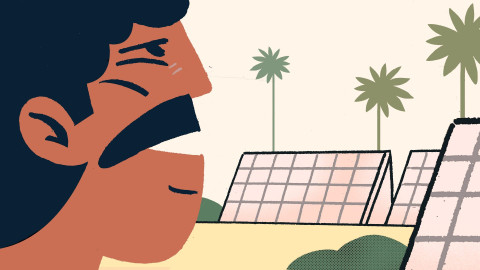
Some avenues for a just energy transition in Morocco
The liberal energy model has failed both economically and ecologically, particularly with regard to energy and climate justice. Official reports, including that of CESE, partly acknowledge this failure, while continuing to advocate for more liberalization, dismantling and privatization of the whole energy sector.
There will be no just transition as long as the energy sector remains under the control of foreign transnational companies and a local ruling elite that is free to plunder the state and generate as much profit as it wishes, within a culture of authoritarianism and nepotism. The debt system and PPPs are a major obstacle to any national – or even popular – sovereignty, including energy sovereignty.
A just energy transition requires the local population’s sovereignty at every stage of the production process: design, implementation, operation, storage and distribution. The energy sector must be considered a public service, co-managed by the workers involved and the local populations who agree to share part of their territories (land, water, forests, etc.) for the collective interest. In this framework, local populations should also benefit from preferential tariffs, if not wholly free electricity services. The current bureaucratic forms of government must be replaced by local and decentralized forms of governance.
Prioritizing decentralized solutions and projects also means bringing energy production as close as possible to users, in order to avoid Joule-effect losses33 and to limit transport costs. This also implies designing smaller-scale projects for which the necessary funds can be mobilized locally or with the help of the state.
Regional integration schemes must also emerge based on the principles of solidarity and the common interest. Such integration is also much more adapted to the physical nature of electricity: the necessary balance between production and consumption means that holders of surplus energy have as much interest in giving it up as those who need it have in receiving it, in order to avoid a general shutdown of the electricity supply.
Against the neoliberal tyranny and the current imbalance of power which benefits the ruling classes, various forms of discontent and protest by local populations are rising. These efforts seek to build alternatives to private profit obtained at the expense of the community and to neo-colonialism, of which privatizations are both an instrument and a symbol. If we genuinely want to build a fairer and more democratic society it is essential that we heed these initiatives, support them and link energy transition to socio-economic issues.